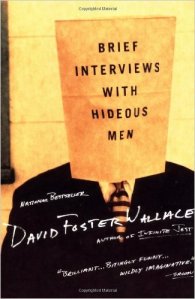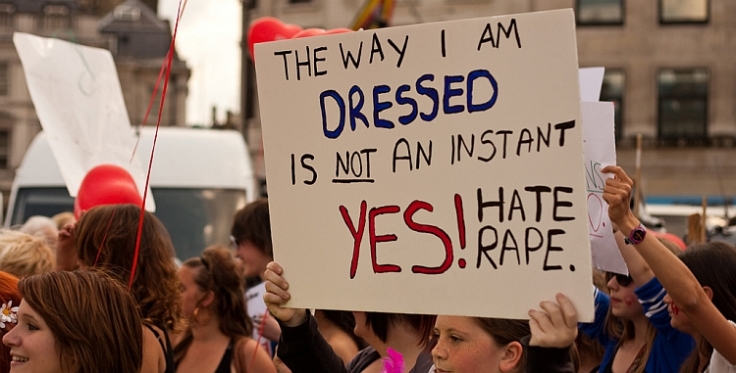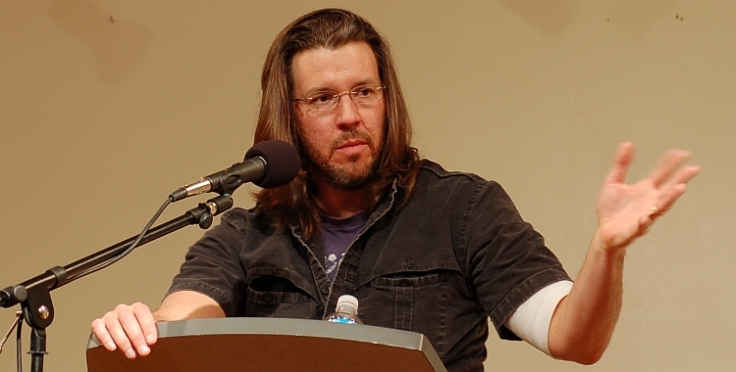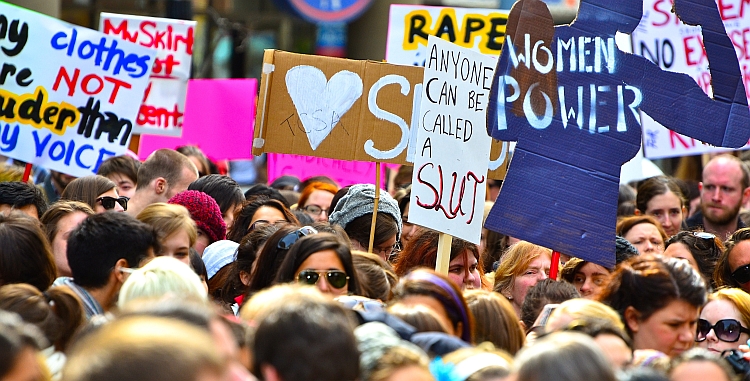A serial womaniser. A commitment-phobic boyfriend. A wife beater. David Foster Wallace’s 1999 book Brief Interviews with Hideous Men presents a provocative view of male misogyny and its effects on women. In this brief interview with READ, which expands upon his recent Postgraduate English article, Matthew Alexander suggests that Wallace’s work is an important text for our times, especially in the light of current debates about rape culture.
For the benefit of anyone who hasn’t read Brief Interviews with Hideous Men, can you give us a sense of what it is like?
 Brief Interviews is a 1999 collection of 23 short stories, with 4 of the stories titled “Brief Interviews with Hideous Men” (across which there are 18 actual “interviews” in total). It’s a hotchpotch of styles, voices, and registers. The content varies massively from one story to the next, which creates a kind of dizzying effect when reading. The stories can be very dark at times and at other times just plain bizarre, and yet there are also some lighter moments.
Brief Interviews is a 1999 collection of 23 short stories, with 4 of the stories titled “Brief Interviews with Hideous Men” (across which there are 18 actual “interviews” in total). It’s a hotchpotch of styles, voices, and registers. The content varies massively from one story to the next, which creates a kind of dizzying effect when reading. The stories can be very dark at times and at other times just plain bizarre, and yet there are also some lighter moments.
I think of the text as a form of social commentary – one that makes the reader hyper-aware of the notion of self-consciousness; in fact, I view this aspect as pivotal to the text because if the reader is willing to engage, there is much to be gained from a reading of it. Brief Interviews opens up the possibility of multiple viewpoints for the reader to adopt, though this is not always a pleasant experience. John Krasinski’s film-version (2007) of the book tends to adopt fixed viewpoints, and for that reason I’d say be wary of forming opinions from it alone – the book, as is often the case, is far more rewarding.
So who are the ‘hideous men’ being interviewed?
All of the stories take the form of transcript conversations with men, where we get to hear their voices but never that of the interlocutor, yet it is the interlocutor who gets to decide how much of the transcript the reader has access to (so there are some interesting power dynamics going on). Some of the “interviews” do appear to be interview-like, but there is also an overheard conversation between two men, and others that seem to capture personal discussions that are not at all interview-like, and while some are brief, others are most definitely not. Also, the “hideous men” stories only account for around a third of the overall book, and not all of the men can be considered to be hideous if we define hideous as morally offensive rather than the more common definition of being offensive to the senses and especially to sight (which as far as we know they’re not). So, in a way the “brief,” “interviews,” and “hideous” parts of the title are misnomers.
We know very little about the men. Their names are largely absent. We are given the date, town, and State where each “interview” is held, and occasionally a specific location in addition to this. Other than that, one might say that they appear to embody particular stereotypes of men: the serial womaniser; the commitment-phobic boyfriend; the misogynist who adopts politically-correct rhetoric in order to disguise his misogyny; the overly confident guy who dominates conversations; the wife-beater – a lovely bunch, all in all.

And who does the interviewing?
Someone identified as Q, whom we know very little about. This makes Q’s inclusion yet absence from the text most fascinating (Krasinski’s film literalises Q by casting the actor that plays her, spoiling this effect). Wallace spoke of Q in interviews as a female interlocutor, yet there are “Brief Interviews” where the text does little to confirm Q as female, and others where gendered pronouns are not in use, which means that at times we cannot even be sure that the interviewees are male – yet the book’s title influences the reader in this respect. The situations that Q encounters further suggest that it is possible to view Q as not just a single person, but as multiple Qs. This seems fitting when we consider that the more we read the text, the more questions (Qs) arise; in fact, we may also notice the cues (Qs) within the text that influence our reading of it, and the way that language-use guides us in this respect.
In your article, you note that Wallace admitted that he was “‘interested in misogyny” when writing the book. What type of misogyny does Wallace explore? Latent sexism? Outright sexual violence?
one reading of this might be that a self-confessed straight, white, privileged male is suggesting that women are in some way responsible for misogyny
Latent sexism, rape culture, and sexual violence are prevalent throughout the text and his approach here is provocative, and perhaps more interesting to consider when Wallace, in a discussion with Michael Silverblatt, states the root cause of misogyny as being based in a “kind of fear.” Wallace posits that men are fearful of being objectified by women, and that it is equally horrifying for a man to be objectified by a woman as it is the other way round. He even goes as far as to say that he is not interested in misogyny in the way that “a whole lot” of people are in the “current cultural locus.” Here, Wallace seems to be referring to feminism and the rise of Gender Studies. This is where the provocative element appears, because one reading of this might be that a self-confessed straight, white, privileged male is suggesting that women are in some way responsible for misogyny.
Well, what do you think? Is he suggesting women are responsible for misogyny?
The first thing to say here is that trying to pin Wallace down to any kind of firm conclusion is fraught with difficulty because of the way he uses language to set up certain situations, whilst always covering himself, if you will, by providing the opportunity for contradictory readings. Wallace’s own self-consciousness makes some of his writing impossibly convoluted in that he tries to explain every proposition in the minutest detail. To think that a writer such as this would leave himself open to such criticism perhaps misses the subtler points to his writing, yet Wallace has been criticised for being misogynistic and even sexist.
Do I think he provides a viewpoint where we can consider women to be just as responsible for misogyny as men? Yes, and this is an idea that is now gaining traction amongst what we might consider to be third-wave feminist thinking, where women’s complicity in the status quo of societal norms is now being proposed. However, I also think that in Brief Interviews Wallace lays bare the most extreme examples of misogyny for a particular reason, much of which centres around rape and sexualised violence, and that in doing so the reader is literally forced to confront the horrors that human beings inflict upon each other in the name of “difference.” Here, Wallace provides us with a snapshot of what we might call “rape culture,” but he also picks away at its veneer to reveal that women aren’t the sole victims/survivors of this.

Is Wallace critical of rape culture? Or does he merely represent its existence?
The fact that rape and sexualised violence feature throughout Wallace’s works of fiction could suggest that he is merely noting its existence, but I think the level to which he makes these topics deeply uncomfortable for the reader suggests something more. What Wallace does different to many of his contemporaries is that he provides a widened sense of perspective, and does not just spout dominant rape culture rhetoric. For instance, in Wallace’s fiction the reader is as likely to read about child rape, incestuous rape, disability rape, and male rape, as well as the conventional tropes associated with rape (the attractive girl/woman and the psychotic stranger, for example). I don’t ever remember reading such things in novels by Martin Amis, Bret Easton Ellis, Jonathan Franzen, Philip Roth, or Hubert Selby Jr., for example, which all seem to trot out the conventional tropes.
To my mind, Wallace aligns more closely with Angela Carter’s depictions of rape and sexualised violence, which is peculiar when you think about it.
In light of recent stories such as the Stanford case, which revealed how rape victims are often silenced and how sympathy sometimes aligns with the perpetrator, what do you think Wallace can tell us about the problems society is wrestling with?
In part, Wallace’s texts expose the absurdities that dominate our culture, and the way in which our thoughts are influenced by such a culture. “BI #42,” from the series of stories in Brief Interviews is perhaps the most vivid example of this. There are no firm conclusions to be reached in “BI #42.” The gang-rape victim (survivor) could be the male protagonist, or just a generic woman, or it could be his wife – but then again, he may not even be married. So, who does the reader end up feeling empathy for, and how does s/he reach that conclusion?
The Stanford case, in a way, provides a real-life “hideous man” for us to consider. If we approach Brock Turner’s crimes with the same sense of self-consciousness that Brief Interviews implores of us, along with a consideration of Turner’s father’s thoughts on his son’s “20 minutes of action,” and the judge’s decision to pass a sentence that takes more account of the perpetrators future than it does of the survivor’s future, arguably, then we are better placed to recognise the absurdity of the handling of the case. And perhaps change may occur as a result of this, because in spite of decades of feminism there still exists a huge rift between men and women – society fairly encourages such a rift, but you have to be able to recognise that before you can attempt to do something about it. That’s what Wallace’s texts can tell us about society’s problems.

It sounds like Wallace might be a difficult writer to read, not only because of his subject matter but also because of his style. Why should readers persevere with him?
Brief Interviews may be thought of as grim, disturbing, and not an easy read. In fact, reflecting on its publication, Wallace described himself as perhaps “the literary equivalent of the person who writes ‘Help me’ on the mirror without knowing it.” Yet Wallace’s writing is infused with tenderness and his arrangement of language is simply beautiful, and at times poetic (the opening paragraphs of The Pale King, for example). There is also a lot of humour in Wallace’s works, where laugh-out-loud moments are sprung upon the reader unexpectedly. His journalistic pieces are very easy to read (Google “cruise ships” and “lobster” for the most popular of these) and you get a sense whilst reading that he is writing with your reading pleasure in mind. That’s why I’d urge readers to persevere with Wallace. There’s so much scope to his writing that if there’s a particular essay, short story, novel, journalistic piece, or indeed non-fiction work that just isn’t doing it for you, simply put it down and try the next one.
Matthew Alexander’s article Engaging with David Foster Wallace’s Hideous Men is available to read now, in the new issue of our open access journal Postgraduate English.




Reblogged this on the textual silence project….
LikeLike
Thank you for this. I think what makes Wallace hard is that he respected the intelligence of his reader and asked for their engagement and wrestling with his text and topics. In Brief Interviews, one way he does this is by leaving the Q.’s blank, sometimes a sort of “complete this as a homework exercise.” So rather than just entertaining us, Wallace sought to educate, involve, and challenge us to look at the world’s and our own wrongs more closely. And this is hard to do too. I agree that the journalistic pieces are great to read, but they are deceptively easy. Actually, I think they are equally challenging in subject matter and in demand on the reader to engage. Infinite Jest shows Wallace as a master short-story writer who succeeded in weaving many threads into a tapestry which hangs together.
LikeLiked by 2 people
Thanks for commenting. I like your description of Wallace’s journalistic pieces as being deceptively easy, for he does seem to try so hard to make them accessible to the reader, and yet there are layers to peel away at if you have the inclination. And yes, I agree about their challenging subject matter – the Lobster piece is a great example of Wallace writing with humour, but then you have the whole ethical debate of whether it’s okay to drop an animal into a pot of boiling water whilst still alive.
LikeLike